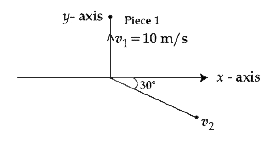Kinetic energy of the particle is E and it's De-Broglie wavelength is λ. On increasing it's KE by δE, it's new De-Broglie wavelength becomes λ2. Then δE is
4E
3E
2E
E
The correct Answer is:B
Step by step video & image solution for Kinetic energy of the particle is E and it's De-Broglie wavelength is lambda. On increasing it's KE by delta E, it's new De-Broglie wavelength becomes lambda/2. Then delta E is by Physics experts to help you in doubts & scoring excellent marks in Class 12 exams.
Updated on:21/07/2023Topper's Solved these Questions
Similar Questions
A ball of mass 10 kg moving with a velocity 10√3m/s along the x-axis, hits another ball of mass 20 kg which is at rest. After the collision, first ball comes to rest while the second ball disintegrates into two equal pieces. One piece starts moving along y-axis with a speed of 10 m/s. The second piece starts moving at an angle of 30 with respect to the x-axis. The velocity of the ball moving at 30∘ with X-axis is x m/s. The configuration of pieces after collision is shown in the figure below.
The value of x to the nearest integer is ______

View SolutionDerive the relation between the wavelength (lambda) of the de broglie wave and kinetic energy (E ) of a moving particle
View SolutionA free particle with initial kinetic energy E, de-Broglie wavelength lambda , enters a region where in it has a potential V, what is the new de-Broglie wavelength?
View SolutionKinetic energy of the particle is E and it's De-Broglie wavelength is λ. On increasing it's KE by δE, it's new De-Broglie wavelength becomes λ2. Then δE is
View SolutionThe de Broglie wavelength (lambda) of a particle is related to its kinetic energy E as
View Solutionदे-ब्रॉग्ली तरंगदैर्ध्य λ कण की गतिज ऊर्जा E पर निर्भर करता है -
View SolutionIf the kinetic energy of a moving particle is E , then the de-Broglie wavelength is
View SolutionKinetic energy of the particle is E and it's De-Broglie wavelength is lambda . On increasing it's KE by delta E , it's new De-Broglie wavelength becomes lambda/2 . Then delta E is
View SolutionKinetic energy of the particle is E and it's De-Broglie wavelength is λ. On increasing it's KE by δE, it's new De-Broglie wavelength becomes λ2. Then δE is
View SolutionThe de Broglie wavelength of a particle of kinetic energy K is lambda . What would be the wavelength of the particle, if it's kinetic energy were K/4.
View SolutionA particle is moving with kinetic energy E. It's de Broglie wavelength is—
View Solutionde-Broglie wavelength of electrons of kinetic energy E is λ. What will be its value if kinetic energy of electrons is made 4E ?
View SolutionDerive the relation between the wavelength (λ) of the de broglie wave and kinetic energy (E) of a moving particle
View SolutionIf the kinetic energy of a moving particle of mass m is E, then the de Broglie wavelength λ is
View SolutionA particle moving with kinetic energy E has de Broglie wavelength lambda .If energy Delta E is added to its energy the wavelength become (lambda)/(2) value of Delta E is
View SolutionIf the kinetic energy of a moving particle of mass m is E, then the de Broglie wavelength λ is
View Solution
